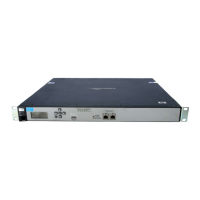LLDP
Overview
17-2
Overview
The IEEE 802.1AB Link Layer Discovery Protocol (LLDP) provides a standards-based method
for network devices to discover each other and exchange information about their
capabilities. An LLDP device advertises itself to adjacent (neighbor) devices by transmitting
LLDP data packets on all ports on which outbound LLDP is enabled, and reading LLDP
advertisements from neighbor devices on ports that are inbound LLDP-enabled. An LLDP
enabled port receiving LLDP packets inbound from neighbor devices stores the packet data
in a Neighbor database (MIB).
LLDP information is used by network management tools to create accurate physical network
topologies by determining which devices are neighbors and through which ports they
connect.
LLDP operates at layer 2 and requires an LLDP agent to be active on each network interface
that will send and receive LLDP advertisements. LLDP advertisements can contain a variable
number of TLV (type, length, value) information elements. Each TLV describes a single
attribute of a device.
When an LLDP agent receives information from another device, it stores it locally in a special
LLDP MIB (management information base). This information can then be queried by other
devices via SNMP. For example, the HP ProCurve Manager software retrieves this
information to build an overview of a network and all its components.
Note LLDP information is only sent/received on Ethernet links. LLDP information is not collected
from wireless devices connected to an AP.
LLDP-MED
LLDP provides the base capabilities for network devices, but was not considered sufficient
for IP telephony devices. As a result, in 2004, an initiative by ProCurve and was undertaken to
enhance LLDP so that it could better support IP telephony devices. The development of
LLDP-Medium Endpoint Discovery (LLDP-MED) (ANSI/TIA-1057/D6) extended the LLDP
standard to support advanced features on the network edge for VoIP endpoint devices with
specialized capabilities and LLDP-MED standards-based functionality. The extensions to
LLDP include the specification of additional TLV (Type, Length, and Value) entries
specifically for VoIP management. LLDP-MED benefits include:
Plug-and-play provisioning for MED-capable, VoIP endpoint devices.
Simplified, vendor-independent management enabling different IP telephony systems to
interoperate on one network.
Automatic deployment of convergence network policies that includes voice VLANs,
Layer2/CoS priority, and Layer 3/QoS priority.
Configurable endpoint location data to support the Emergency Call Service (ECS) such
as Enhanced 911, 999 and 112.
Detailed VoIP endpoint data inventory readable via SNMP from the switch.

